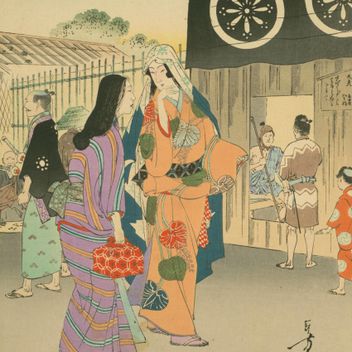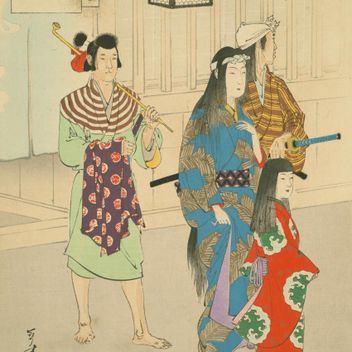三十六佳撰
Sanjūroku Kasen
Mizuno, Toshikata1893 · Akiyama, Buemon

Details
- Title
三十六佳撰
Sanjūroku Kasen
- Date
- 1893
- Period
- Meiji
- Artist
- Mizuno, Toshikata
- Publisher
- Akiyama, Buemon
- Art
- Printing,
- Woodblock Printing,
- Nishiki-e
- Medium
- Paper,
- Ink
- Collection
- National Diet Library
Description
Mizuno Toshikata’s work Sanjuroku-Kasen, also called Thirty-Six Beauties, is a collection of Japanese woodblock prints created between 1891 and 1893.
In this series, Toshikata depicts elegant ladies from 35 different historical periods, ranging from the 7th century to the first half of the 18th century, when the Edo period ended and just before the onset of the drastic modernization of the Meiji period.
Sanjuroku-Kasen draws on a broader tradition in Japanese art known as bijin-ga, which depicts beautiful women from various walks of life, including noblewomen and courtesans. Yet the series also melds the bijin-ga theme with the artist’s interest in historical subjects.
The title is a play on the word “kasen.” Here, the phrase means “Selection of Thirty-Six Beauties” but it also phonetically sounds like “Thirty-six Immortal Poets,” echoing a classic theme in Japanese literature that has been adapted in various paintings and prints over time.
Toshikata was a painter who meticulously researched the historical periods he depicted. For example, he took lessons in yūsoku kojitsu, the study of the traditions of the medieval imperial court, from the nobleman Matsubara Sukehisa. He also founded the Rekishi Fūzoku Gakai (Society for Historical Genre Painting) with Imperial Household Artist Kobori Tomoto and the historical scholar Seki Yasunosuke, to study history with experts and like-minded artists.
Toshikata’s careful depictions of clothing, hairstyles and settings reveal his attention to historical detail and ability to capture the essence of past eras. The Sanjuroku-Kasen series is a wonderful example of his unique style and appreciation of cultural heritage.
From this series

Kōka-goro Nagoya fujin

Bunsei-goro fujin

Bunka-goro fujin

Kansei-goro fujin

Tenmei-goro fujin

An'ei-goro ki-fujin

Meiwa-goro fujin

Hōreki-goro fujin

Kan'en-goro fujin

Enkyō-goro fujin

Kanpō koro fujin

Bunkyū-goro fujin

Kyōhō-goro fujin

Shōtoku-goro fujin

Hōei-goro fujin

Genroku-goro fujin

Jōkyō-goro fujin

Enpō koro fujin

Tenna koro fujin

Enpō koro fujin

Kanbun-goro fujin

Manji-goro fujin

Meireki-goro fujin

Jōō-goro fujin

Shōhō-goro fujin

Keian-goro fujin

Genna-goro fujin

Kan'ei-goro fujin

Keian-goro fujin

Ōnin-goro fujin

Kōshō-goro fujin

Hōtoku-goro fujin

Bun'an-goro fujin

Genkō-goro fujin

Kenkyū-goro fujin

Jōdai-goro fujin